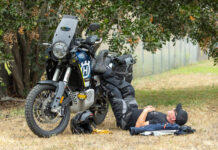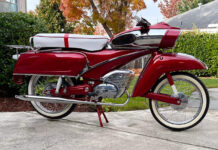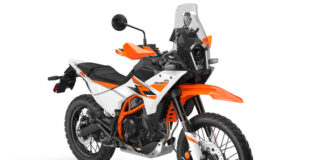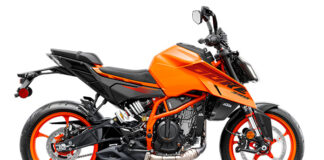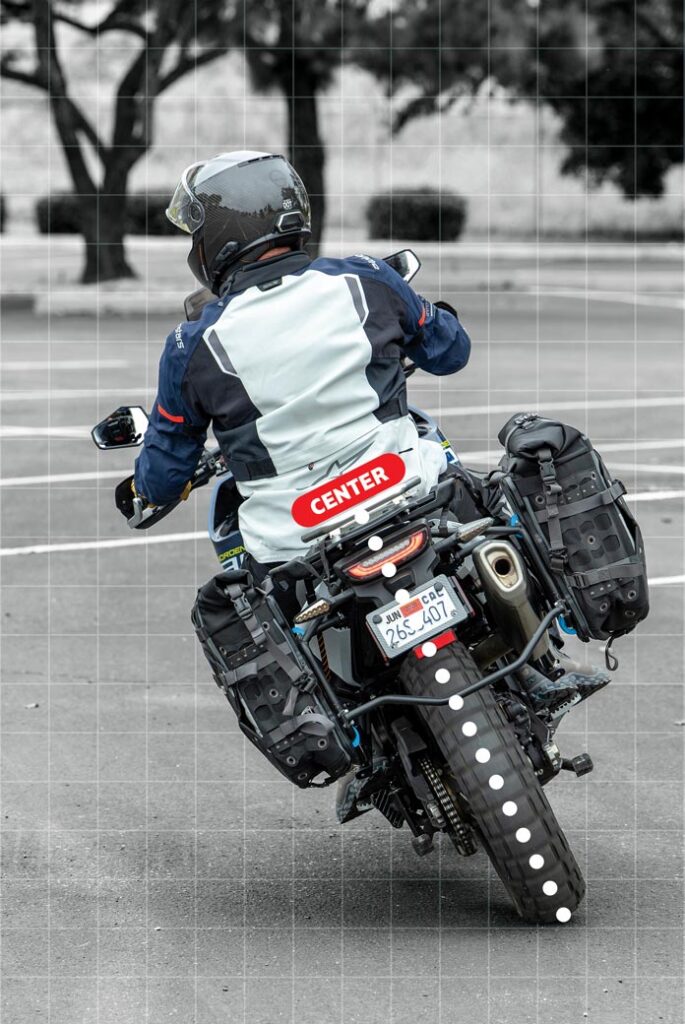
Today we’re going to learn how to use our hips to improve our motorcycle’s initial drop into a turn and reduce the turning radius for tight maneuvers. What’s more, while all that cool stuff is happening, we’ll gain a more counterbalanced rider position in the cockpit, resulting in more balance and comfort as we go. It’s utterly amazing how well this works, but it can also feel utterly embarrassing as you learn how to do it. The benefits are far too great to pass up, so suck it up, buttercup, and push through it. Don’t worry, you got this!
Exercise 1: Unlock Your Hips
To kick off this lottery-winner of a lesson, we’re going to unlock the range of motion in your hips. To do this, I want you to stand in front of the bathroom mirror and get those hips swaying. With your feet shoulder-width apart for stability and hands on your hips, start moving your hips side-to-side. You’ll want to keep your pelvis loose, so it might help to pop in a Prince cassette and crank it up. Pay attention to your upper torso and ensure that it remains still and calm. We don’t want the hip movement to unsettle our overall body posture when we transition to the motorcycle.
Once you can see and feel that your hips are really extending out to the sides, we are going to add steering input to the party by imagining we are holding onto our handlebar and steering in the direction of our hip movement. The key here is to ensure that our timing is consistent, which means our hips and simulated bar movement extend to the left or to the right at the same time. Do this until you feel completely silly and can’t do it any longer. Then knock out three more sessions.
Exercise 2: Circle Drill
Okay Elvis the Pelvis, now we’re going to take your cool hip swagger and transfer it to the motorcycle. In a large, safe space, start riding around a circle that’s about 30 feet in diameter while keeping your speed under 20 mph. You need to generate a sustained (but safe and friendly) lean angle as you ride around the circle. Once the motorcycle is settled into a lean, isolate your hips and move them laterally, holding them left and then right, executing a full circle in each hip position.
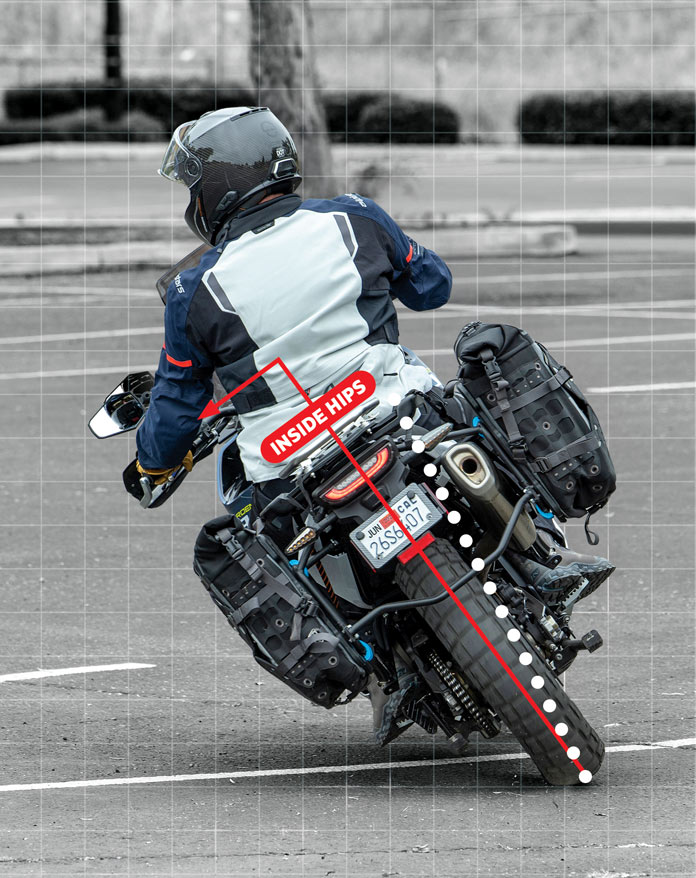
The goal here is to impact the motorcycle’s lean angle and turning radius by shifting our hips. Your lean angle will decrease and the turning radius will get larger (the circle gets bigger) when you shift your hips away from the direction the motorcycle is leaning. That’s because shifting your hips to the outside lifts the bike up out of the lean. Conversely, your lean angle will increase and the turning radius will get smaller when you shift your hips in the same direction the motorcycle is leaning. You’ll be using your hips to push the bike down.
As you do this exercise, you will notice that the degree to which your body is counterbalanced will depend on the direction your hips move in the circle. Shifting your hips away from the motorcycle’s lean angle (to the outside) will generate a less counterbalanced body position; shifting your hips toward the motorcycle’s lean angle (to the inside) will generate a more counterbalanced position.
Trust me on this, and execute 10 circles in each direction, concentrating on shifting your hips laterally back and forth until you can comfortably and repeatably alter your motorcycle’s turning radius and feel how the technique affects how counterbalanced you are with each hip position.
Exercise 3: Oval Drill
Next, we are going to practice using this technique to improve the initiation of a turn. Until today, we have initiated a turn by generating a counter-steering effect with a bar press on the handlebar. Want to turn right? Press on the right-side hand grip. Do the opposite for a left turn. Adding some disco-hip-action in the direction we want to turn can also generate a counter-steering effect. Bringing the two together – a bar press plus a hip shift – results in a larger counter-steering effect that requires less effort to initiate a turn. This is a biggie.
For this exercise, set two cones approximately 60 feet apart and start slow, comfortable U-turns initiated with an inside bar press. After completing a handful of laps around the cones in each direction, add the hip movement to the U-turn. In other words, execute the traditional inside bar press and – at the exact same time and direction – generate lateral force with your hips. Remember, because you are now employing two tools to initiate turns, you will experience a substantially easier (and more rapid) turn-in than from a bar press alone. That means you need to take it slow on your initial hip input – a little goes a long way. Work this exercise for approximately 10 minutes in each direction until it is comfortable and repeatable.
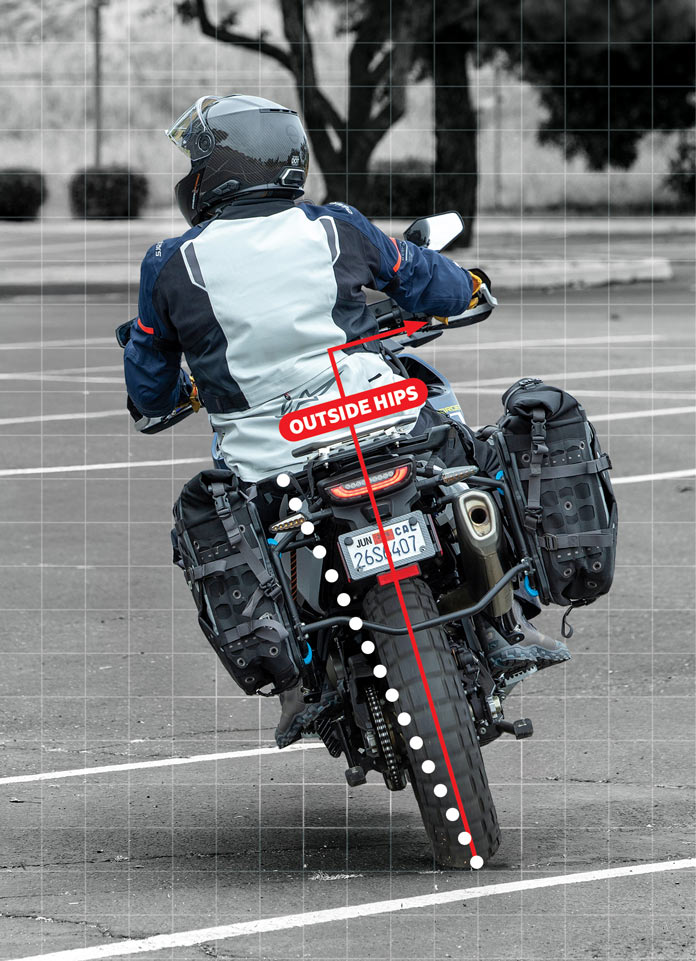
Exercise 4: Figure-8 Drill
Ready for one more? This final exercise brings it all together by transitioning us back and forth in a figure-8 pattern. Using two cones spaced 60 feet apart as before, our goal here will be to efficiently transition our hips from left turns into right turns, with consistent timing between the initial bar press and lateral hip movement. As you work this drill, make sure to hold your lateral hip position all the way through the turn, only moving back to center once you have finished turning around. This is important because you don’t want to change your radius and lean angle mid-corner by shifting your hips too early. As you gain comfort and fluidity with the technique, tighten up the pattern and put in more reps to get it nailed down.
It is critical that you take your time working these exercises. That might mean 15-20 minutes or more in front of the mirror feeling the burn, followed by a couple hours on the grinder. You will eventually acclimate to the amount of input necessary to generate the comfortable, predictable, hyper-efficient turns that this technique offers. Start slow, take your time, and stick with it until it feels natural. I promise it will pay huge dividends on the motorcycle.
It will help to see this technique in action. To watch me demonstrate it, go to YouTube.com/@PoliceMotorTraining and watch “How To Make Tight Turns Easier On Your Motorcycle.”
Quinn wears Schuberth helmets and Lee Parks Design gloves. Find out more at Quinn’s website, PoliceMotorTraining.com. Send feedback to rider@ridermagazine.com.

